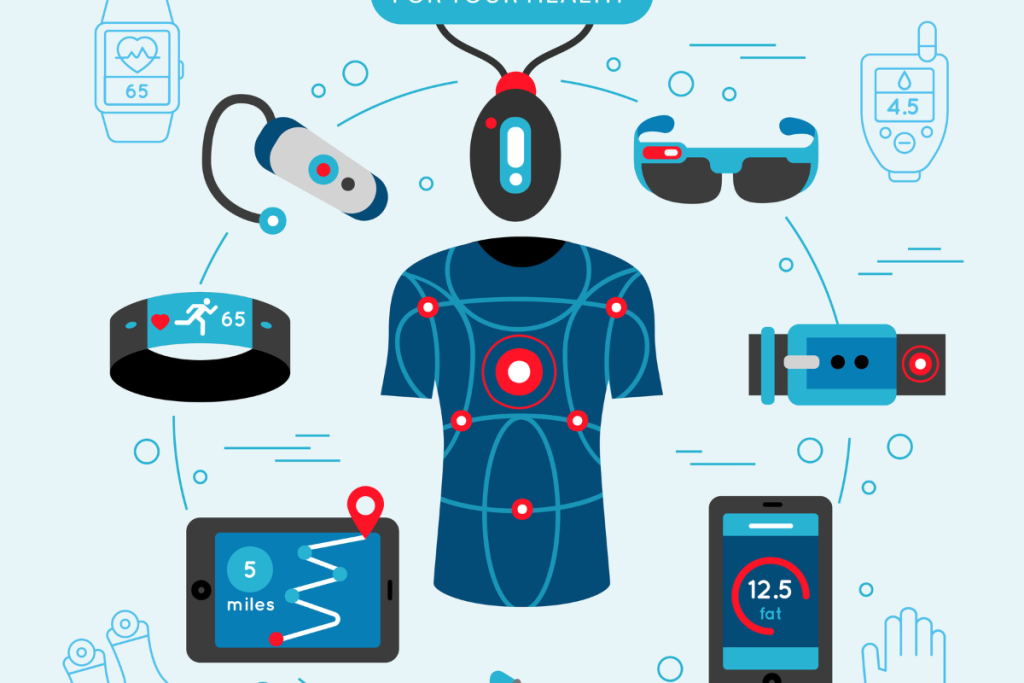Introduction
Wearable technology has progressed beyond mere step counters and simple digital watches. By 2025, it has transformed into a multifaceted ecosystem that encompasses fitness, healthcare, communication, and even productivity in the workplace. Increasing consumer expectations, along with advancements in artificial intelligence and compact sensors, have propelled this change. As lifestyles shift towards being more data-centric, wearables are becoming personal companions that connect human requirements with technological advancements As lifestyles become more data-centric, wearables are evolving into personal companions, bridging human needs with technological innovation. How do you see wearable tech shaping our future?”
Smartwatches: Still the Core of Wearable Tech?
Smartwatches remain the most popular wearable device category, dominating the market with their versatility.
- Health Monitoring: Heart rate tracking, ECG scans, sleep analysis, and blood oxygen levels are now standard.
- Connectivity: They extend smartphone functions from calls and texts to navigation directly on the wrist.
- Lifestyle Integration: Payment systems, productivity apps, and entertainment tools are making watches indispensable.
Despite the growing variety of wearables, smartwatches continue to serve as the “hub,” integrating with other devices like wireless earbuds and fitness bands to provide a seamless digital experience.
Fitness Bands vs. Health Monitors: Where’s the Edge?
Fitness bands were once at the forefront of the wearable technology revolution, providing basic functionalities such as step counting and calorie tracking. Nevertheless, consumer expectations have evolved towards more specialized health monitoring.
- Fitness Bands: Cost-effective, lightweight, and perfect for casual fitness tracking.
- Advanced Health Monitors: These devices concentrate on delivering medical-grade insights, monitoring blood pressure, glucose levels, and even early indicators of chronic conditions.
- The advantage now resides in the precision and comprehensiveness of the data. While fitness bands continue to be favored for their straightforwardness, advanced health monitors are increasingly gaining traction as preventive healthcare becomes a worldwide priority.
Smart Clothing: The Next Big Leap
Smart clothing embodies the most advanced facet of wearable technology, integrating sensors within fabrics to monitor bodily metrics in real time.
- Sports Performance: Athletes utilize smart shirts and footwear that assess exertion, posture, and endurance.
- Healthcare Applications: Garments equipped with embedded biosensors can continuously monitor vital signs, providing physicians with access to real-time data.
- Everyday Utility: Envision jackets that automatically regulate temperature or professional attire that tracks stress levels.
Although still in its nascent phase, smart clothing is set to revolutionize wearables, transforming them from mere accessories into indispensable lifestyle equipment.

How AI Is Powering Smarter Wearables
Artificial Intelligence (AI) has emerged as the foundation of contemporary wearable technology, evolving devices from mere data collectors into intelligent companions.Through predictive analytics, wearables are now capable of alerting users to irregular heartbeats before they escalate into critical issues, while personalization features enable AI to tailor fitness objectives and health recommendations to the distinct needs of each individual.Simultaneously, AI-driven voice and gesture control enhance the intuitiveness of these devices, facilitating natural interactions.The seamless integration with smartphones, home devices, and cloud platforms further amplifies their functionality.This shift towards intelligence is advancing wearables beyond mere passive tracking, establishing them as proactive allies in health, lifestyle, and professional environments.
What Challenges Hold Wearable Tech Back?
Despite the progress, wearable technology faces significant hurdles:
- Privacy & Data Security: Health and lifestyle data raise serious concerns about misuse.
- Battery Life: Consumers want lighter devices without sacrificing power.
- Affordability: Advanced wearables are still priced out of reach for many.
- Adoption Barriers: Not all users find wearables comfortable or aesthetically appealing.
- Regulatory Concerns: Especially in healthcare, approval processes slow down innovations.
For wearables to become truly mainstream, these challenges must be resolved with a focus on trust, accessibility, and functionality.
Everyday Life, Work, and Healthcare: Who Benefits Most?
The genuine influence of wearable technology can be observed in various sectors:
- Daily Life: Tools for fitness tracking, stress assessment, and productivity enhancement contribute to an improved standard of living.
- Work Environments: Workers gain advantages from time-management applications, wellness initiatives, and augmented reality devices used for training purposes.
- Medical Field: Both healthcare providers and patients benefit from ongoing monitoring, which facilitates early intervention and tailored treatment strategies.
The primary beneficiaries are individuals in the healthcare sector, where wearables have the potential to decrease hospital visits, lower expenses, and even preserve lives by identifying problems at an earlier stage.
Conclusion
From fitness trackers to intelligent apparel, wearable tech has grown well beyond mere novelty items. It is transforming how individuals live, work, and manage their health. The future of wearables depends not on standalone gadgets, but on cohesive ecosystems driven by AI, data protection, and user confidence.
In numerous aspects, the future of wearables has already arrived advancing quickly to be more anticipatory, more individualized, and more vital. Similar to how wearables assist people in creating healthier, more efficient lives, professionals also require platforms that facilitate growth and worldwide connectivity. This is where Wiraa, an international remote job platform, creates an influence. By connecting talent with worldwide possibilities, Wiraa helps professionals establish authority and achieve long-term success in a global digital landscape.




